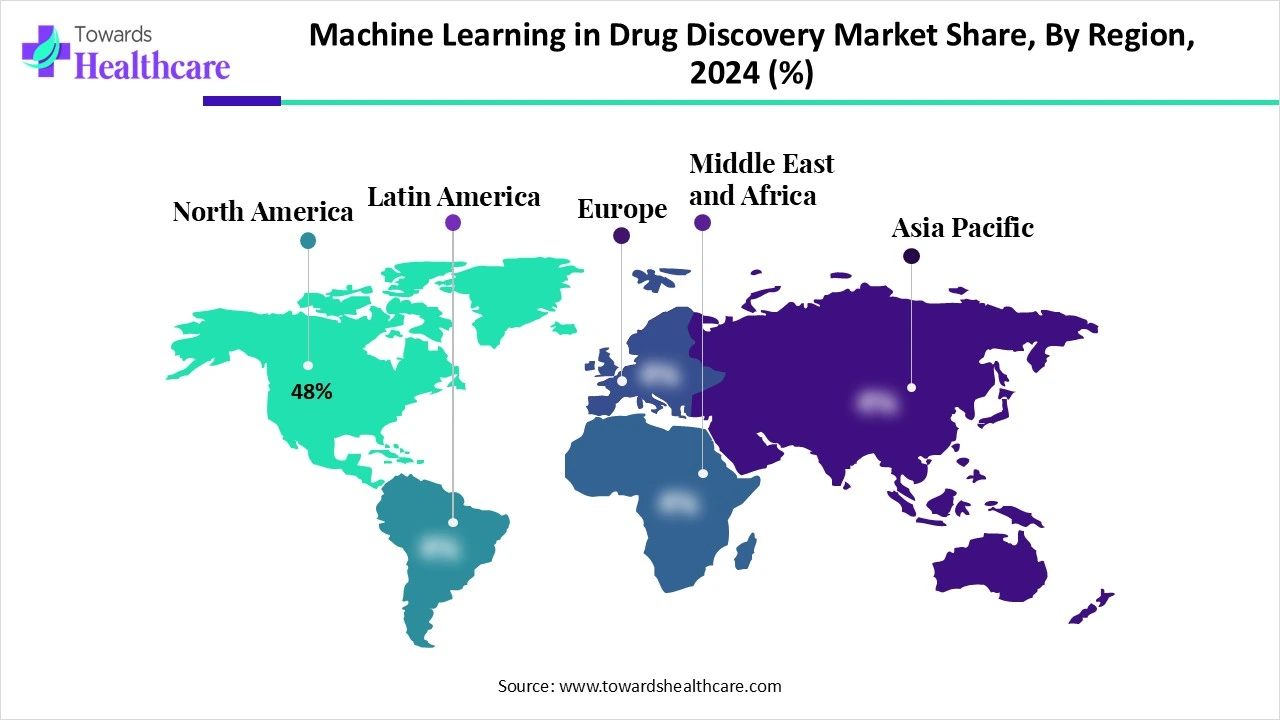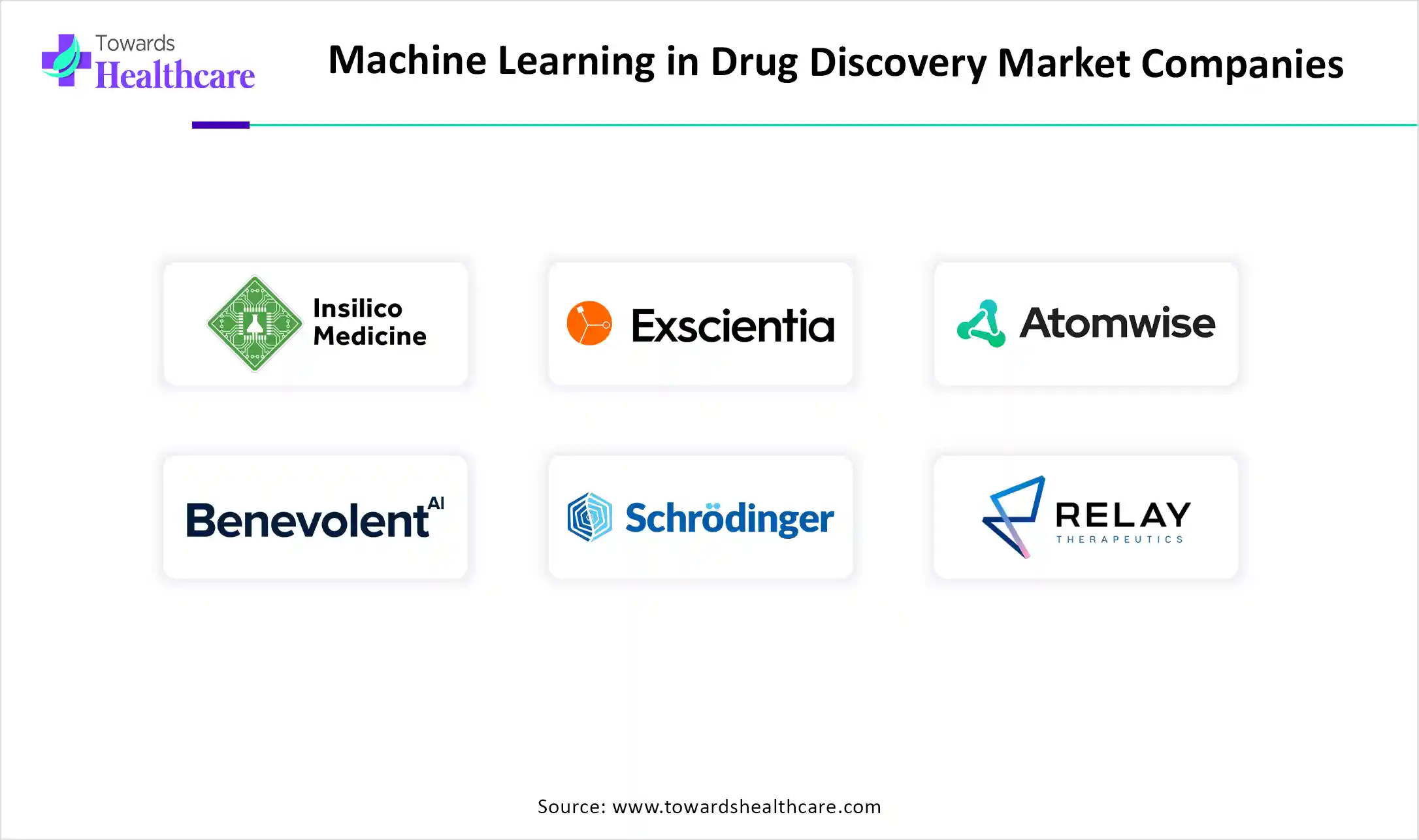November 2025

The worldwide machine learning in drug discovery market is experiencing significant expansion, with projections indicating a revenue increase reaching several hundred million dollars by the end of the forecast period, spanning 2025 to 2034. This growth is driven by emerging trends and strong demand across key sectors.
The global machine learning in drug discovery market is experiencing significant growth due to different factors, like growing cases of chronic and complex diseases, along with rising demand for personalized medicine by analyzing huge data is propelling demand for advanced ML tools to develop potential drug candidates. Furthermore, this market is evolving into many opportunities in the future, including novel drug or therapy development under the sophisticated ML facilities, boosting AI-driven startups, and accelerating collaborations with various pharmaceutical and biotechnology companies.

Machine Learning (ML) in Drug Discovery refers to the use of algorithmic models that learn from large datasets to identify patterns, predict outcomes, and make data-driven decisions across the drug discovery process. ML accelerates early-stage research, enables the identification of novel drug candidates, enhances target validation, optimizes lead compounds, and predicts toxicity and pharmacokinetics, thereby reducing R&D time and cost. Recently, drug discovery coupled with AI and ML algorithms, drug as Rentosertib, has been used in the treatment of Idiopathic Pulmonary Fibrosis, and the increase of generative models for drug molecule design. In this, machine learning is also involved to accelerate the accuracy and speed of toxicity assessment, virtual screening, and drug-target interaction predictions.
Enhanced Efficiency and Prediction Rates
Across the world, the global machine learning in drug discovery market is experiencing crucial growth due to the ability of ML algorithms to analyse huge datasets, including chemical, biological, and clinical, accelerates than other conventional approaches, resulting in faster identification of possible drug candidates. This also leads to improved efficiency and minimized spending and time in the drug development process. As well as ML models assist in the prediction of drug-target interactions and ADMET to enhance the chances of discovering an efficient drug molecule is driving the market growth.
Lack of Expenses and Specialized Expertise
Major challenges arriving in this market include the training of complex ML models, which require crucial computational resources, rising expenses, and time. Along with this, a shortage of professionals in pharmaceutical companies with essential skills to evolve and execute ML models efficiently is generating another hurdle for the adoption of ML in drug discovery.
Development of a Drug Formulation and Clinical Trial Design
Diverse opportunities, along with target identification and molecule optimization, are involved in the global machine learning in drug discovery market is rising drug formulations and delivery approaches with improved efficiency and patient-friendly of novel drugs. Also, in clinical trials, ML helps in the analysis of patient data to determine adaptable patient cohorts design for clinical trials, estimate patient responses, and develop trial designs to accelerate success rates and cost-effectiveness. Based on this research, machine learning supports to development of personalized medicine for the prospects.
By application stage, the lead optimization segment dominated the global machine learning in drug discovery market with approximately 30% share in 2024. The segment is fueled by the growing adoption of AI and ML-driven tools for optimizing drug efficiency, safety, and development timelines. As well as this segment usually focuses on refining and boosting potential drug candidates with improved properties for robust therapeutic results and minimal development expenses.
Whereas the clinical trial design & recruitment segment is estimated to expand at the fastest CAGR during 2025-2034. Majorly contributing factors are the raised emphasis on the development of personalized trial models and biomarker-based stratification based on individual patient data. Although growing datasets from electronic health records, genomics, and other sources, coupled with advancements in computing power, provide the basis for advanced ML models to examine and refine significant insights.
The supervised learning segment held a major revenue share (~40%) in the market in 2024. Many advantages of this segment, like its ability to estimate drug activity and properties, utilization of labelled datasets to train ML algorithms to detect patterns and relationships between molecular characteristics and favourable results, are escalating the drug discovery process.
By algorithm type, the deep learning segment is predicted to grow rapidly in the upcoming year. The segment is driven by its rising capabilities in structure-based predictions and alpha-fold use in protein modeling. Along with this, deep learning allows the de novo design of novel drug candidates with desired features, supporting the segment expansion.
By deployment mode, the cloud-based segment led the market with 70% revenue share of the market in 2024. Generally, they have advantages such as their ability to manage large datasets, facilitate collaboration, and enhance the drug development process. As well as rising adoption of cloud-based services from numerous pharmaceutical and biotechnology companies and increasing investments in drug discovery, production is fueling demand for cloud-based solutions to simplify these processes.
However, the hybrid deployment segment is anticipated to expand at a rapid CAGR during 2025-2034. In the market, the segment is propelled by the requirement for integrated strengths of on-premise and cloud-based solutions, which enables companies to grasp the computational power of the cloud while maintaining sensitive data on secure, on-premise systems. Besides this, the need for scalable models with private data integration is also driving the demand for this segment.
By therapeutic area, the oncology segment led with approximately 45% share of the machine learning in drug discovery market in 2024. A rise in cases of various cancer types, which are fueling demand for more efficacious and personalized therapies or treatments in the oncology sector, is propelling demand for machine learning to analyze patient data and enhance drug development. Also, ML helps to optimize drug design with target identification to evolve novel therapies around the world.
On the other hand, the neurological disorders segment is predicted to grow rapidly over the forecast period. The segment is experiencing expansion due to growing incidences of neurological conditions around the globe are highly demanding the use of machine learning algorithms in Alzheimer's and Parkinson's drug discovery processes.
The pharmaceutical companies segment dominated with ~50% revenue share of the machine learning in drug discovery market in 2024. Primarily, these companies are increasingly investing in AI and ML technologies through both internal and external collaborations with AI companies to accelerate their drug discovery capabilities. Whereas, developing different chronic and complex diseases is highly fueling the demand for novel and efficient drug molecules is driving the segment and overall market growth.
By end user, the AI-focused startups segment is estimated to register the fastest growth in the studied years. Along with the growing large datasets and ongoing advancements in AI and ML technologies, VC-backed innovation and fast prototyping are propelling these startups to enhance drug development approaches.

North America held the biggest revenue share of 48% of the market in 2024. The region expansion is fueled by increasing funding and investments in AI and ML-powered drug discovery by pharmaceutical companies, startups, and venture capitalists. Besides this, as AI and ML are streamlining the clinical trials by identifying patient populations, improvements in trial designs, and estimation of success rates are resulting in robust and successful trials in this region.
Mainly, the market is experiencing major growth due to the US FDA’s regulatory support in impelling AI applications in drug development, such as fast-track initiatives, fostering innovation and adoption. As well as the US also has a robust hub of bioinformatics and expertise involved in it, which is vital for developing and executing ML algorithms.
For instance,
A significant factor incorporated in the market expansion is Health Canada encouraging guidance on the utilization of machine learning-driven medical devices, such as those employed in drug discovery, to achieve desired safety and efficacy. As well as growing adoption of cost-effective and novel technologies in drug discovery by Canada, is fueling the demand for ML tools and the drug discovery approaches.
Asia Pacific is estimated to grow at the fastest CAGR during the forecast period, driven by emerging factors like a widespread wealth of biological data, such as genomic information and electronic health records, which are important for training AI and ML models used in drug discovery. Also, this region has strong IT infrastructure and rising digitalization of healthcare records, due to the increasing diversity of cases is enabling the adoption of AI and ML-powered tools or solutions in faster drug development. Along with this, developing countries like China and India are stepping towards AI investments and possess a major availability of genomic data.
As mentioned above, increasing AI investments and the availability of genomic data are broadly fueling the market in India. Also, India has been involved in several startups that are highly emphasizing on use of AI and ML for drug discovery is significantly contributing to the market expansion.
For this market,
The Chinese government is widely investing in biotechnology for genomic and cancer-related research activities to fulfill the demand for growing cancer and genetic disorders cases in China. These growing investments in novel drug molecule discovery and efficient therapies are fueling demand for AI and ML-driven tools to develop faster and effective drug candidates.
For instance,
Europe is expected to grow significantly in the machine learning in drug discovery market during the forecast period, due to the possession of robust research infrastructure with advanced facilities, including AI and ML tools in drug discovery. Whereas, major collaboration in public and private organizations, along with supportive regulatory considerations by EMA, are enabling the more efficient and rapid drug development. Thriving biotech industries in Germany, France, and the UK are fueling demand for machine learning algorithms.
The Government of Germany is increasingly investing in innovations that are propelling research and development in AI and ML-driven drug discovery. Along with this, this region is highly adopting advancements in computing power are allowing more sophisticated simulations and analyses of drug interactions.
For this market,
Emerging advancements in drug discovery, including AI and ML tools, major partnerships with biotech and pharma companies, and growing large healthcare data, are leveraged by the application of AI and ML algorithms to identify behaviors and correlations, driving the UK market in drug development.
For this market,

By Application Stage
By Learning Type
By Deployment Mode
By End User
By Therapeutic Area
By Region
Market insights predict, the humanized mouse and rat model industry is expected to grow from USD 257.2 million...
Projections indicate that, automated blood processing equipment industry is projected to rise from USD 2.12 bi...
November 2025
November 2025
November 2025
November 2025